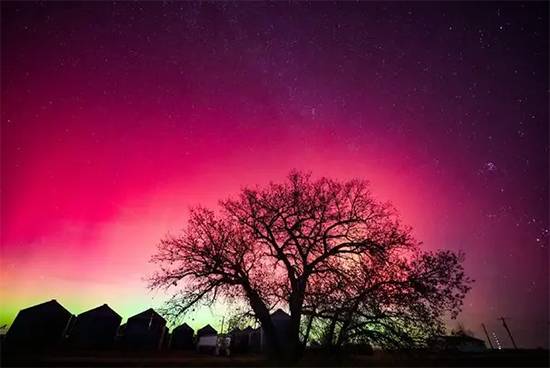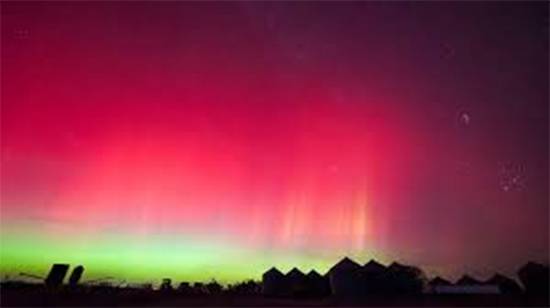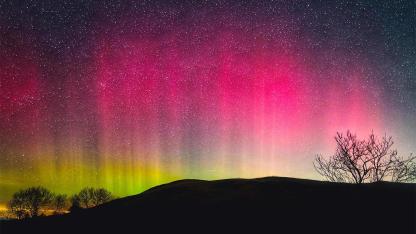Auroras light up the night sky across North America
From the northern reaches of Canada to the warm coasts of Florida, brilliant shades of green, pink, red, and purple illuminated the heavens. The rare display was triggered by a powerful geomagnetic storm — a direct result of massive solar eruptions from the sun known as coronal mass ejections (CMEs).

The Space Weather Prediction Center (SWPC) in Boulder, Colorado, classified the event as a G4-level storm, one of the most severe categories. The intensity of the geomagnetic disturbance not only dazzled onlookers but also prompted warnings about potential disruptions to communication networks, GPS systems, and even power grids. Despite these concerns, the phenomenon captivated observers and photographers, filling social media with mesmerizing images of dancing lights across the continent. This extraordinary event underscores the dynamic relationship between the Earth and the sun — a celestial connection that continues to fascinate scientists and stargazers alike.
What causes the aurora borealis phenomenon
The aurora borealis, commonly known as the northern lights, occurs when charged solar particles collide with gases in Earth’s atmosphere. These interactions release energy in the form of light, creating the shimmering curtains of color that paint the night sky. The hue of each aurora depends on the type of gas involved: oxygen emits green and red tones, while nitrogen produces blue and purplish glows.

The recent light show was triggered by a series of coronal mass ejections — massive bursts of solar plasma and magnetic fields released from sunspots on the sun’s surface. According to SWPC forecaster Shawn Dahl, CMEs on November 9 and 10 were followed by a strong solar flare on November 11. When these eruptions reached Earth, they interacted with the planet’s magnetic field, causing geomagnetic turbulence that intensified the auroras.
Dahl noted that the first two CMEs were “profoundly stronger than anticipated,” while a third, even more energetic ejection was expected to arrive on November 12. This sequence of solar activity is what made the auroras visible in regions far beyond their usual northern latitudes.
Warnings and potential impacts of the geomagnetic storm
While the auroras offered a stunning spectacle, space weather experts also emphasized the potential risks associated with such strong geomagnetic storms. The SWPC warned that the ongoing activity could affect satellite communications, GPS accuracy, and electrical infrastructure.
“For people who rely on precision GPS — such as surveyors or agricultural operators — measurements could be off by several inches or more,” Dahl explained. “It’s a temporary effect, but it can cause real challenges during periods of intense solar activity.”
In anticipation of possible disruptions, the SWPC communicated with key agencies, including space launch operators, utility grid managers, and White House officials. These precautionary measures help ensure that essential systems remain stable even during severe space weather events.
Geomagnetic storms like this one can also interfere with radio transmissions and cause voltage irregularities in high-latitude power systems. Although widespread power outages are unlikely, the risks highlight how interconnected modern technology is with solar conditions.
A rare spectacle for southern states
Perhaps the most remarkable aspect of this storm was how far south the auroras could be seen. Reports and photographs flooded in from states rarely touched by the phenomenon — including Texas, Florida, Alabama, Arkansas, and South Carolina. Social media platforms buzzed with excitement as users shared vivid images of glowing skies and streaking colors stretching across the horizon.

Such widespread visibility occurs only when solar storms are exceptionally strong. Typically, auroras are confined to regions closer to the Arctic Circle, such as Canada, Alaska, and northern Europe. However, during intense events, Earth’s magnetic field channels the solar particles farther south, expanding the reach of the auroral oval. For many in the southern United States, this was a once-in-a-lifetime experience — a dazzling display of nature’s raw power and beauty.
What to expect next in solar activity
Scientists are closely monitoring the sun’s activity in the coming days, as the solar cycle approaches its peak phase, known as solar maximum. During this period, sunspots and flares become more frequent, increasing the likelihood of geomagnetic storms and visible auroras.
According to forecasts, the third CME from this week’s solar activity is expected to reach Earth around midday on November 12, potentially sparking another night of colorful skies. Skywatchers are advised to check the Space Weather Prediction Center’s real-time aurora forecasts to determine visibility in their area.
For the best viewing conditions, experts recommend heading to dark, open spaces away from city lights and looking north shortly after sunset. Even if the lights fade, their appearance serves as a reminder of the magnificent forces at play between our planet and the sun.
The wonder of the northern lights
Beyond the scientific explanations, the aurora borealis remains one of Earth’s most enchanting natural wonders. It bridges art and science — blending physics, atmosphere, and sheer visual poetry. The November 11 event reminded people across North America how deeply connected we are to the cosmos.
Whether you’re a scientist, photographer, or casual observer, witnessing the aurora firsthand leaves an unforgettable impression. And as the sun continues its active cycle, the opportunity to see these vivid, shimmering lights may arise again — painting the sky with nature’s most brilliant brush.












Yorumlar
Kalan Karakter: